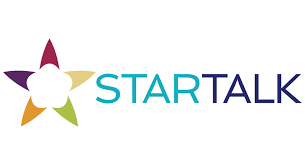The 2024 Hindi and Urdu Teacher Training Institute is conducted online, and it is designed to enhance the knowledge and skills of school, community, and college teachers of Hindi and Urdu. The program results from a partnership between and is funded by the Hagop Kevorkian Center, New York University, the South Asian Institute, the University of Texas at Austin, the Asian Studies Center, and Michigan State University. The program awards a completion certificate for 50 hours to all participants who completed the coursework.
For admissions and other information, click on the menu above.
The schedule is as follows (all times are EST):
- Thursdays: 8:00 am-11:00 pm
- Saturdays: 10:00 am -12:00 pm
- Sundays: 10:00 am-2:00 pm.
- May 25-June 2: Orientation Week 1 = 16 hrs
- Asynchronous: 1 hrs (LMS set up, lesson plan document uploads)
- Synchronous: 15 hrs
- June 3 June 23: Weeks 2-4 = 30 hrs
- Asynchronous: 3 hrs
- Synchronous: 9 hours per week
- June 24-June 30: Final Week 5 (Final Project Presentations ) = 5 hrs
- Asynchronous: 1 hrs
- Synchronous: 4 hrs
Total = 51
Objectives: After completing this training institute, teachers will be able to:
- Identify effective instructional practices and provide evidence from sample lessons and/or classroom videos supported by checklists;
- explain and implement practical instructional principles related to backward lesson design, 21st-century World-Readiness Standards, students-centeredness, and performance tasks development based on real-life;
- in pairs/small groups, develop 3+ lessons based on backward design, including a theme, 2+ World-Readiness Standards, specific age and proficiency level, 2+ CanDo statements (NCSSFL-ACTFL document), appropriate vocabulary and structures for this plan;
- and adapt authentic materials appropriate for the proficiency levels in their instructional context;
- identify and adopt appropriate authentic materials for designing 3+ tasks at different proficiency levels;
- design engaging tasks in the three modes of communication
- explain why specific strategies are practical and/or ineffective when staying in the target language and providing comprehensible input after they observe or participate in a sample online lesson in Bulgarian;
- examine and rate the proficiency level of ‘can do’ statements in the interpersonal and presentational modes, and assess levels of learners from recorded OPI interviews;
- explain what inclusive course instruction, materials, and classroom atmosphere are and provide examples of how to manage difficult dialogues in the classroom related to social justice and current affairs ;
- use and implement educational technology tools of their choice in their lessons for the three modes of communication;
- reflect on the effectiveness of current learning objectives, lessons, and assessments vis-a-vis heritage vs. foreign language learners.
The details of the hours are as follows:
- Orientation Week (self-introductions, surveys, and introduction to Google Classroom features, ed-tech tools, fonts/typing, zoom features, tech support, etc.): asynchronous 4 hrs and 3 hrs consultation lab = 7 hrs
- Weeks 1-4: Asynchronous 8 hrs per week = 32 hrs; Synchronous 9 per week (Tuesdays 2 hrs + 1 hr consultation lab, Thursdays 2 hrs + consultation lab 1 hr and Sundays 2 + consultation lab 1 hrs ) = 36 hrs
- Weeks 5-6 (final project work): asynchronous 4 hrs + 1 hr consultation lab + 2 hrs
synchronous (final presentations through multiple round-tables in breakout rooms) = 12hrs
Total = 87
The synchronous sessions are as follow (all times are EST):
Week 1:
Tuesday, June 8 — 4:00-7:00pm
Thursday, June 10 — 4:00-7:00pm
Sunday, June 13 — 4:00-7:00pm
Week 2:
Tuesday, June 15 — 4:00-7:00pm
Thursday, June 17 — 4:00-7:00pm
Sunday, June 20 — 4:00-7:00pm
Week 3:
Tuesday, June 22 — 4:00-7:00pm
Thursday, June 24 — 4:00-7:00pm
Sunday, June 27 — 4:00-7:00pm
Week 4:
Tuesday, June 29 — 4:00-7:00pm
Thursday, July 1 — 4:00-7:00pm
Monday, July 5 — 4:00-7:00pm
Week 6:
Sunday, July 18 — 4:00-6:00pm
The program is offered as non-credit option, however, successful alumni can apply for a competitive graduate course stipend (minimum 3 available).
Objectives: After completing this training institute, teachers will be able to:
- explain and implement principles related to backward lesson design, 21st century World Readiness Standards and performance tasks development based on real-life;
- identify and adapt authentic materials appropriate for the proficiency levels in their instructional context;
- design engaging tasks in the three modes of communication
- reflect on the effectiveness of current learning objectives, lessons, and assessments vis-a-vis heritage vs. foreign language learners;
- apply principles related to backward design and literacy-based pedagogy to their own courses;
- create and teach online a part of a Novice level lesson conducted exclusively in the target language
No Fees
The program provides about 87 hours, equivalent to a one-semester course. The program aims to recruit and support instructors at small colleges and departments, community schools and organizations. It provides training and network information to members of the heritage community with a minimum of a Bachelor’s degree and superior or higher language skills considering a career in the language-teaching field.
It is also an opportunity for practicing school teachers with the target language skills who teach other disciplines to consider developing an additional skill in teaching their native language and eventually to pursue a foreign language teaching certificate.
